Heading out on a road trip is exciting, but before you hit the open road, make sure your car is ready. One of the most overlooked aspects of road trip prep is your tires. Your tires keep your vehicle safely connected to the road, and if they’re not in great shape, your trip could become a lot riskier than it needs to be. Worn or damaged tires affect your car’s performance and can lead to accidents, breakdowns, or costly delays. To save yourself the hassle, here are five clear signs that your tires might not be road trip-ready, along with tips for checking and fixing any issues.
1. Low Tread Depth
The tread on your tires gives them a grip on the road, especially in wet or slippery conditions. Shallow tread makes it harder for your car to maintain control, increasing the risk of skidding or hydroplaning.
How to Check
You can use the “penny test” to check your tire tread. Insert a penny into the tread grooves with Lincoln’s head facing down. If you can see the top of his head, your tread is too low, and it’s time for new tires. Alternatively, purchase a tread depth gauge for a more precise measurement.
What to Do
Tire treads below 4/32 of an inch should be replaced before your trip. Look for tires designed for the type of driving you’ll do, such as touring tires for long highway drives or all-terrain tires if you’ll be exploring off-road areas.
2. Uneven Wear
Even if your tread seems deep enough, uneven wear can signal something is wrong. Tires that wear unevenly may not perform well on the road, potentially compromising your car’s handling and safety. Uneven wear often points to alignment, suspension, or tire pressure issues.
How to Check
Visually inspect all four tires. Look for spots where the tread looks more worn down compared to the rest of the tire or where one tire is noticeably different from the others. Running your hand along the surface can also help you feel for irregularities, like bald patches or wavy tread patterns.
What to Do
Uneven wear usually requires a trip to a mechanic or tire shop. They can check and fix any alignment issues or suspension problems that might be causing the wear. After the repair, rotate your tires every 5,000-7,000 miles to promote even wear in the future.
3. Cracks, Bulges, or Cuts
Tires take a lot of abuse from potholes, curbs, and debris on the road. Over time, this wear and tear can lead to visible signs of damage, such as cracks, bulges, or deep cuts on the sidewalls. These are major red flags that your tires may be close to failing, as they weaken the tire's structure.
How to Check
Inspect the sidewalls of your tires for anything unusual. Cracks may look like tiny lines running along the surface, while bulges will create an abnormal bump. Cuts may look like deep grooves that penetrate the surface of the rubber.
What to Do
If you spot any of these issues, don’t ignore them. Replace the damaged tire immediately, as it could fail without warning.
4. Low or Uneven Tire Pressure
Tire pressure plays a big role in keeping your car stable and efficient on the road. Driving with low tire pressure increases the rolling resistance, which can hurt your fuel economy and lead to overheating. Uneven pressure across your tires can affect your handling and braking, making your car harder to control.
How to Check
A tire pressure gauge is a handy tool for this. Check the pressure on all four tires and the spare if you have one. Then, compare the readings to your car’s recommended pressure, which you’ll typically find in the owner’s manual or on a sticker inside the driver’s door.
What to Do
Most gas stations have air pumps where you can put air in your tires, but you might need to bring some spare change. If you notice pressure dropping frequently, you might have a slow leak and should have the tire inspected for punctures or valve issues.
5. Old Tires
Even if your tread is deep and your tires look fine on the surface, age can be a problem. The rubber in tires degrades over time, even if they haven’t been used often. Old tires are more likely to crack, lose their grip, or fail under the stress of long-distance driving. Most experts recommend replacing tires every 6–10 years, regardless of wear.
How to Check
Look for the DOT (Department of Transportation) code printed on the sidewall of your tire. The last four digits tell you the week and year the tire was manufactured. For example, a code like “2319” means the tire was made in the 23rd week of 2019.
What to Do
Tires around six or seven years old should be swapped before your trip. Even if they appear to be in good condition, the aging process makes them less reliable.
Final Prep Before Your Road Trip
Start by inspecting tread depth, looking for uneven wear, and checking for any visible damage like cracks or bulges. Don’t forget to measure your tire pressure and confirm that your tires aren’t past their expiration date. If you identify any issues with your tires, take action immediately. Visit a tire shop or mechanic to make 100% sure that your car is road-ready.
 (Image via
(Image via





